In the fast-paced world of content creation, where deadlines are tight and creativity is paramount, writers are constantly on the lookout for tools that can help them streamline their workflow and generate high-quality content efficiently. Enter AI writing tools – a game-changing advancement that has taken the writing industry by storm. These tools leverage the power of artificial intelligence to assist writers in various aspects of content creation, from generating ideas to polishing final drafts. In this comprehensive guide, we’ll dive deep into 15 remarkable AI writing programs that are reshaping the way we approach writing and content generation.
The Power of AI Writing Programs
1. OpenAI’s ChatGPT
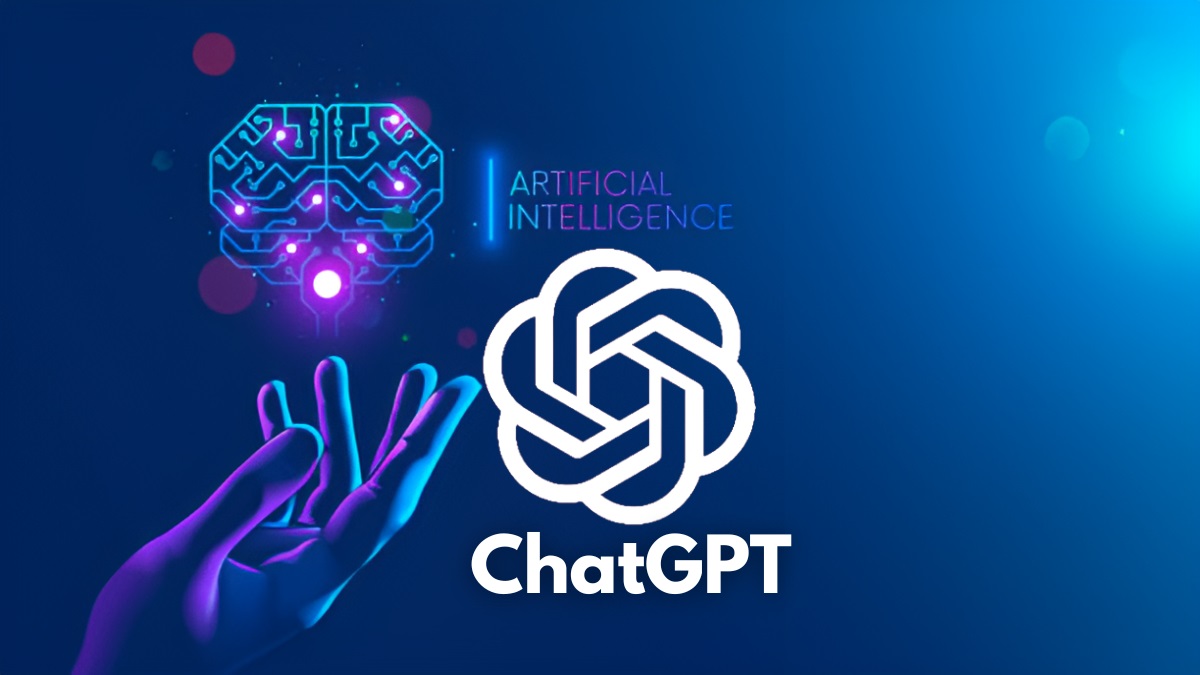
One of the pioneers in AI writing, OpenAI’s ChatGPT offers a versatile platform that generates text based on prompts provided by the user. ChatGPT can be employed for a wide array of tasks, from drafting articles to composing emails, and even writing code snippets.
OpenAI’s GPT-3 model, which powers ChatGPT, boasts a staggering 175 billion parameters, making it one of the most powerful language models ever created.
Pros of OpenAI’s ChatGPT
- Versatility and Flexibility. ChatGPT’s versatility is one of its standout features. It can be utilized for a wide range of tasks, from drafting emails and articles to answering questions and generating creative writing pieces. This flexibility makes it a valuable tool for writers, content creators, and professionals across various industries.
- Natural Interaction. The conversational nature of ChatGPT enables users to interact with the model in a more natural and intuitive manner. This fosters a dynamic exchange that feels remarkably human-like, making it a user-friendly platform for those who might not be well-versed in programming or AI.
Cons of OpenAI’s ChatGPT
- Occasional Inaccuracies. While ChatGPT is impressive in its ability to provide information, it’s not infallible. The model might sometimes generate inaccurate or outdated information, which could lead to potential misunderstandings or errors.
- Lack of Contextual Understanding. ChatGPT’s responses are based on patterns and data it has learned from a wide range of sources. However, it might struggle to fully grasp the context of a conversation, leading to responses that sound plausible but aren’t entirely relevant or appropriate.
2. Grammarly
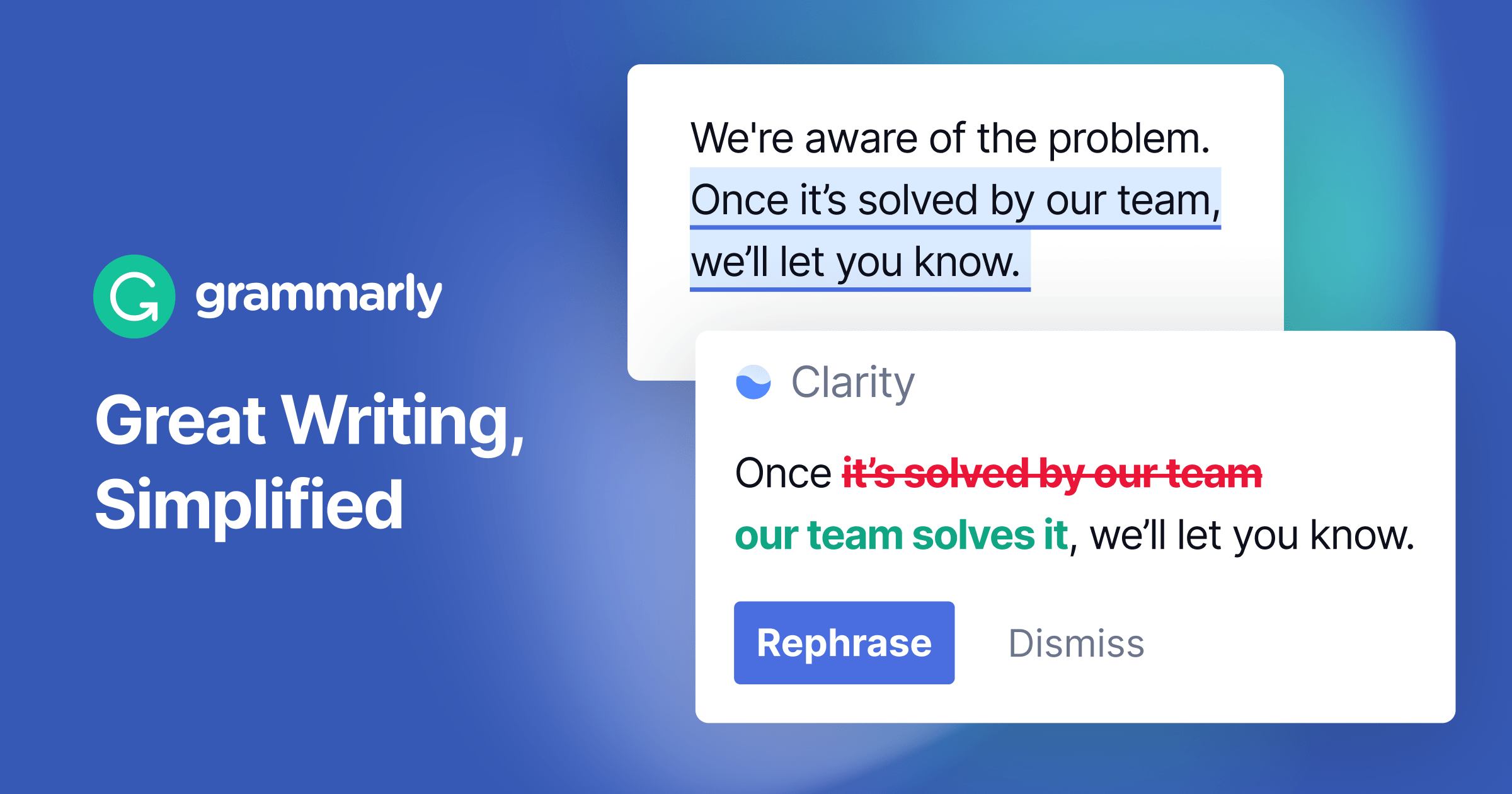
A name synonymous with impeccable grammar and writing assistance, Grammarly’s AI-powered platform not only corrects grammatical errors but also suggests vocabulary enhancements and style improvements. It’s like having a virtual writing assistant by your side.
How does Grammarly’s AI go beyond basic grammar checks to enhance overall writing quality?
Pros of Grammarly
- Effective Grammar and Spelling Correction. One of Grammarly’s primary strengths lies in its ability to detect and correct grammar and spelling mistakes. It provides real-time suggestions that help users maintain a polished and professional writing style, ensuring that their content is free from embarrassing errors.
- Enhanced Vocabulary and Style. Grammarly goes beyond basic grammar checks by suggesting vocabulary enhancements and offering style recommendations. It helps users refine their writing style, making their content more engaging, persuasive, and diverse.
Cons of Grammarly
- Inaccurate Suggestions. While Grammarly is highly effective, it’s not infallible. It might occasionally provide suggestions that are contextually incorrect or unnecessary. Users need to exercise their judgment and discernment when accepting or rejecting suggestions.
- Dependence on Internet Connection. Grammarly operates primarily as a cloud-based tool, which means users need a stable internet connection to access its features. This dependency on the internet might be limiting in environments with poor connectivity.
3. Wordtune
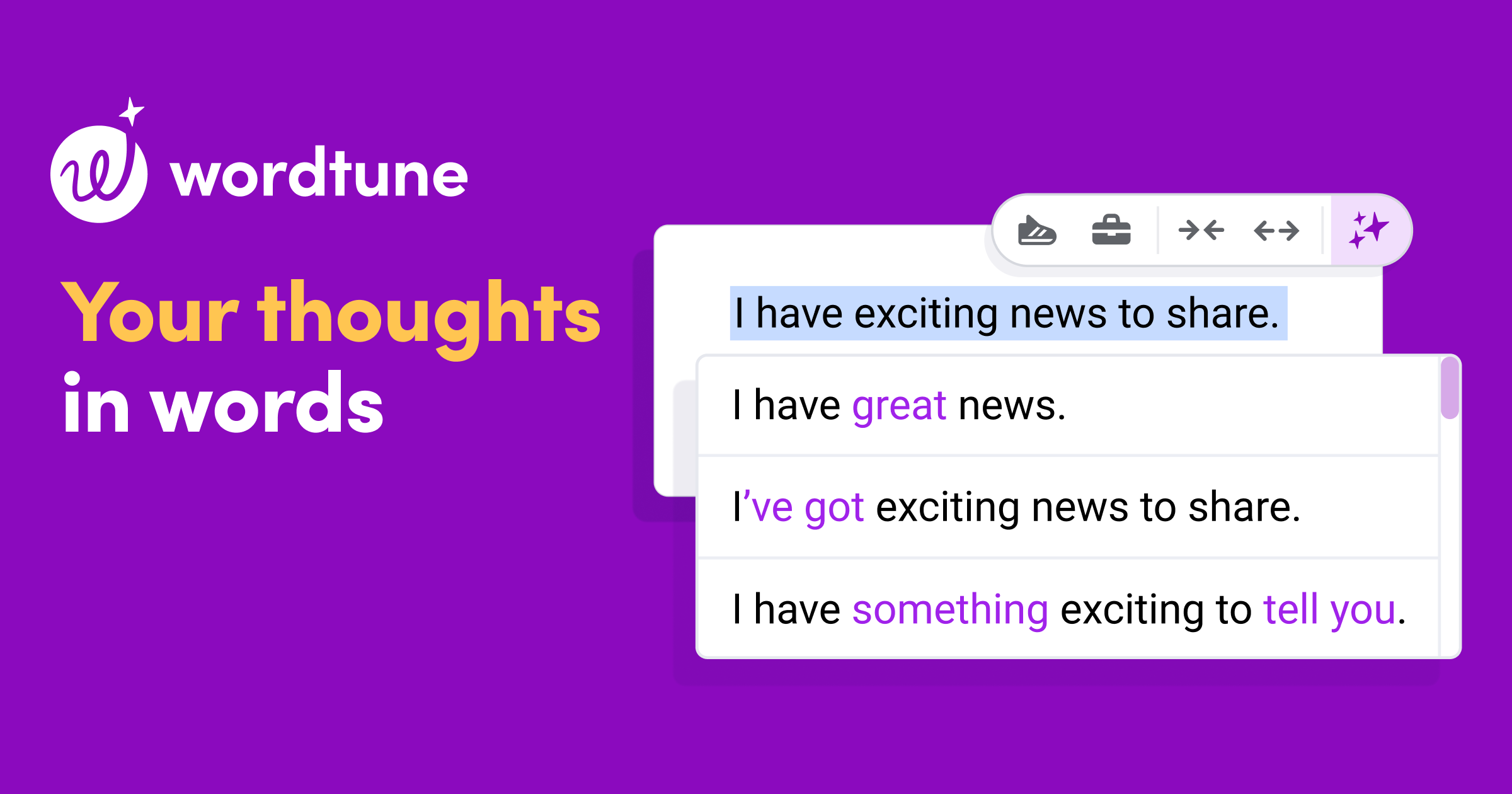
Ever found yourself staring at a sentence, unsure how to rephrase it for better clarity? Wordtune steps in with its AI-driven sentence rewriting capabilities. It offers suggestions to enhance sentence structure and readability.
Think of Wordtune as your writing wingman, always ready to give your sentences a makeover.
Pros of Wordtune
- Sentence Rephrasing Assistance. One of Wordtune’s standout features is its ability to suggest alternative phrasings for sentences. This can help writers overcome writer’s block or find more engaging ways to convey their ideas, ultimately improving the readability and impact of their content.
- Enhanced Clarity and Readability. Wordtune’s suggestions often focus on improving sentence structure and clarity. By providing concise alternatives, it helps writers communicate their thoughts more effectively, ensuring that the content resonates with readers.
Cons of Wordtune
- Contextual Accuracy. While Wordtune excels at suggesting rephrasings, it might occasionally misinterpret the context of the content. Writers need to carefully review the suggestions to ensure they align with the intended meaning of the text.
- Overreliance on AI Suggestions. There’s a risk that writers may become overly reliant on Wordtune’s suggestions, neglecting to develop their own writing skills. Striking a balance between using the tool as a resource and honing one’s craft is essential.
4. Article Forge
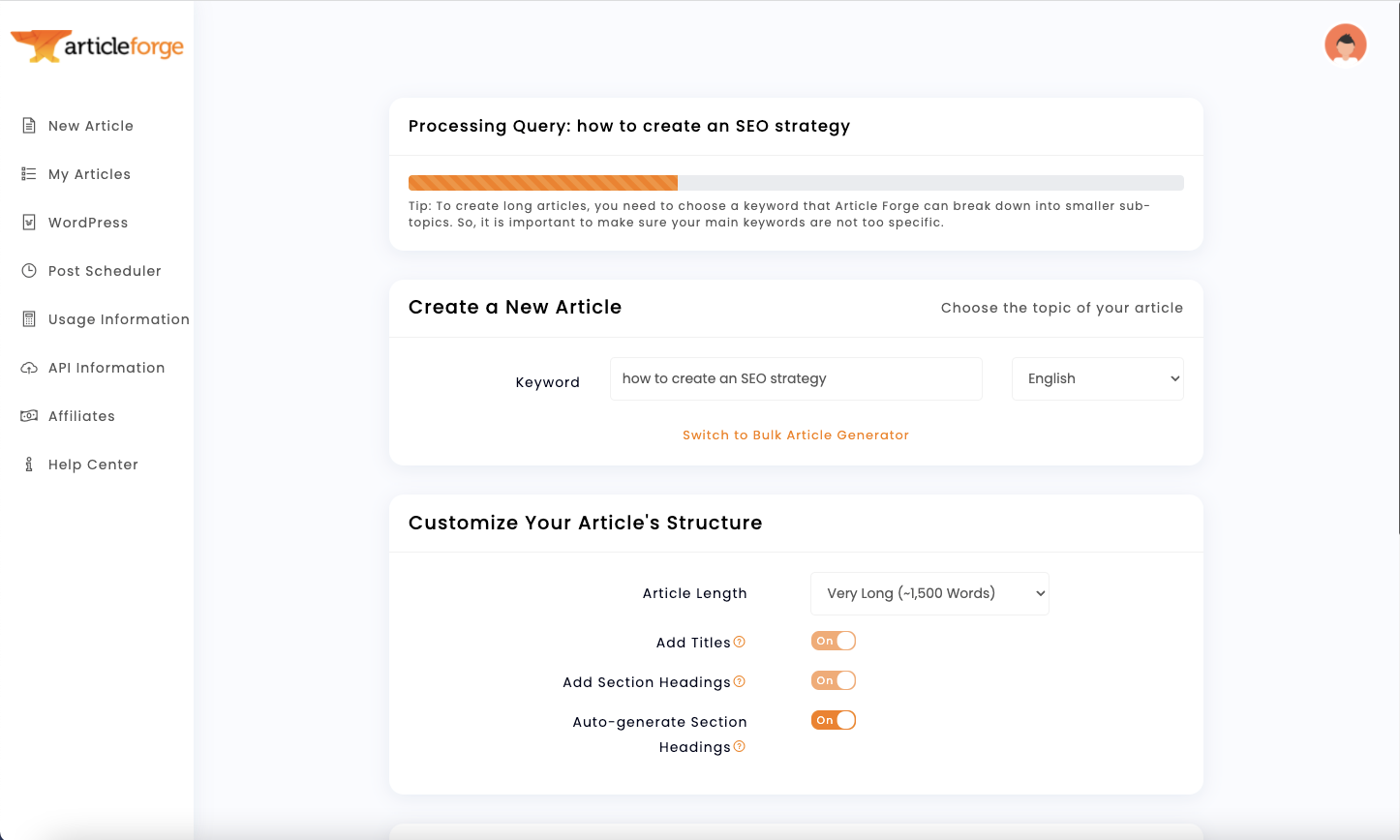
Short on time but need a high-quality article? Article Forge uses AI to craft articles on a given topic by scanning the internet for relevant information. It then generates a unique article that’s ready for publication.
Article Forge can be a lifesaver for content marketers looking to quickly produce SEO-friendly articles for their websites.
Pros of Article Forge
- Time Efficiency. Article Forge’s automated content generation can significantly speed up the process of creating articles. It saves writers valuable time that can be redirected towards other essential tasks, such as research, analysis, or fine-tuning content.
- Bulk Content Creation. For those in need of generating a large volume of articles quickly, Article Forge’s ability to produce content on demand can be a major advantage. It streamlines the creation of multiple pieces within a short span of time.
Cons of Article Forge
- Quality Control. While Article Forge promises automated content, maintaining consistent quality can be a challenge. The generated content might lack the depth, insight, and unique perspective that human-written articles can provide.
- Limited Creativity. Automated content can sometimes lack the creativity and personal touch that human writers bring to their work. It might struggle to produce content that resonates emotionally or offers a fresh and engaging perspective.
5. Writesonic
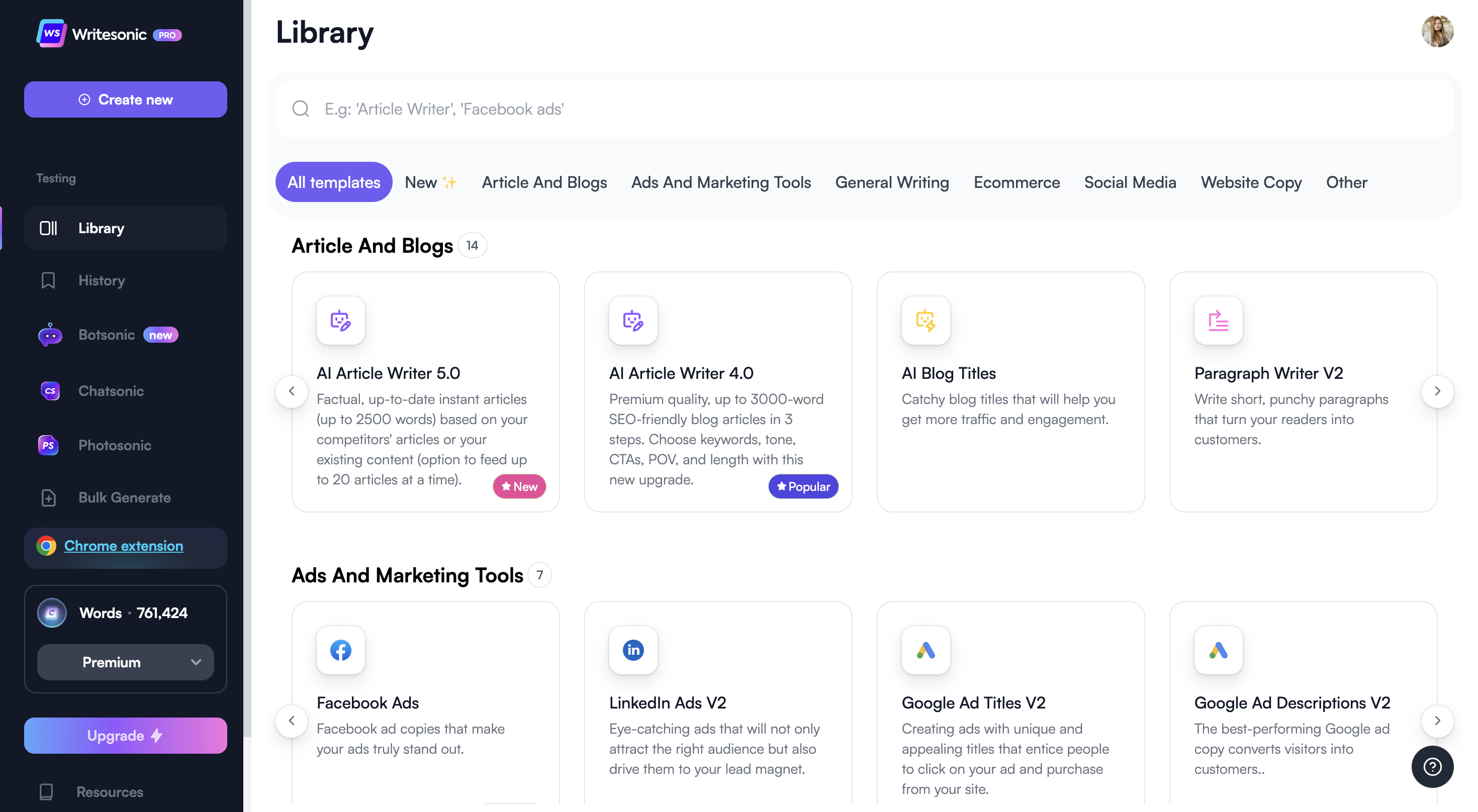
From blog intros to advertising copy, Writesonic tackles a variety of writing tasks. Its AI engine generates content based on prompts and can even create product descriptions by analyzing features and benefits.
With Writesonic, you’re not just getting text – you’re getting strategically crafted narratives that resonate with your audience.
Pros of Writesonic
- Diverse Content Generation. Writesonic shines in its ability to generate diverse types of content, from blog intros and product descriptions to ad copy and more. This versatility makes it a valuable tool for marketers, bloggers, and businesses seeking to address a variety of content needs.
- Time Efficiency. For content creators who face tight deadlines, Writesonic’s rapid content generation can be a lifesaver. It streamlines the content creation process, allowing writers to produce high-quality content in a shorter amount of time.
Cons of Writesonic
- Content Originality. While Writesonic generates content, ensuring its originality can be challenging. Users need to carefully review the output to prevent potential issues of plagiarism or content similarity with existing pieces.
- Contextual Understanding. Writesonic’s AI might struggle with grasping complex nuances and context, leading to content that might not fully align with the intended meaning or tone. Writers need to exercise judgment to ensure accuracy.
AI Writing Tools for Niche Purposes
6. Copy.ai
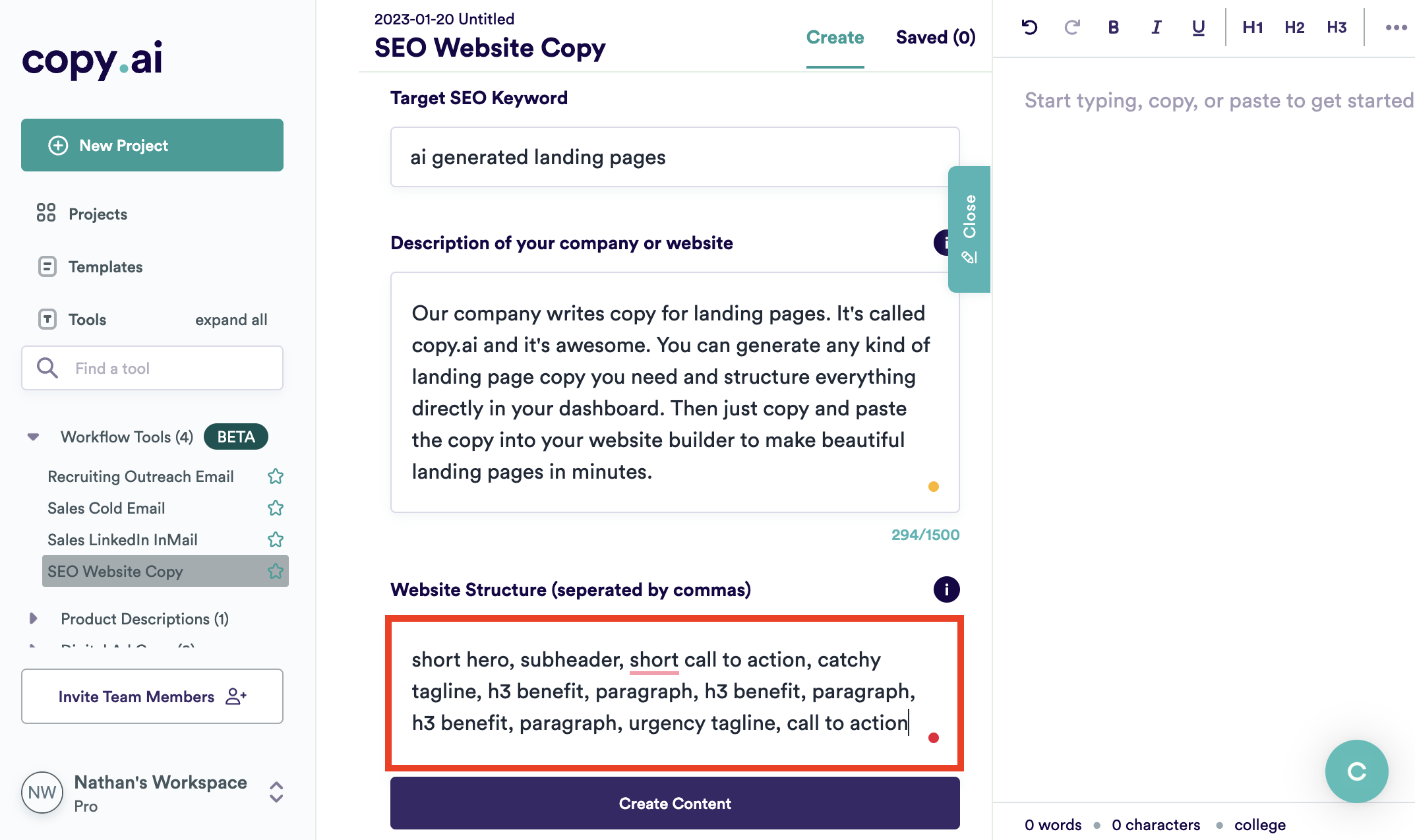
Tailored specifically for marketers and businesses, Copy.ai helps create compelling ad copy, product descriptions, and even brainstorm ideas for blog posts. It’s like having a marketing wordsmith at your fingertips.
How does Copy.ai leverage AI to generate persuasive marketing content that converts?
Pros of Copy.ai
- Efficient Copy Generation. Copy.ai excels in swiftly generating copy for a variety of marketing materials, including ad copy, social media posts, product descriptions, and more. This efficiency can significantly expedite the content creation process.
- Creative Idea Generation. Copy.ai’s AI engine offers creative prompts and suggestions that can spark new ideas and angles for your copy. It assists marketers in exploring innovative ways to convey messages and engage their target audience.
Cons of Copy.ai
- Content Originality. While Copy.ai generates copy, ensuring its originality can be a concern. Users must review the output to prevent potential issues of plagiarism or content similarity with existing materials.
- Contextual Understanding. Copy.ai’s AI might struggle with fully grasping the context and nuances of specific topics or industries. Marketers need to carefully review the generated copy to ensure accuracy and relevancy.
7. AI Dungeon
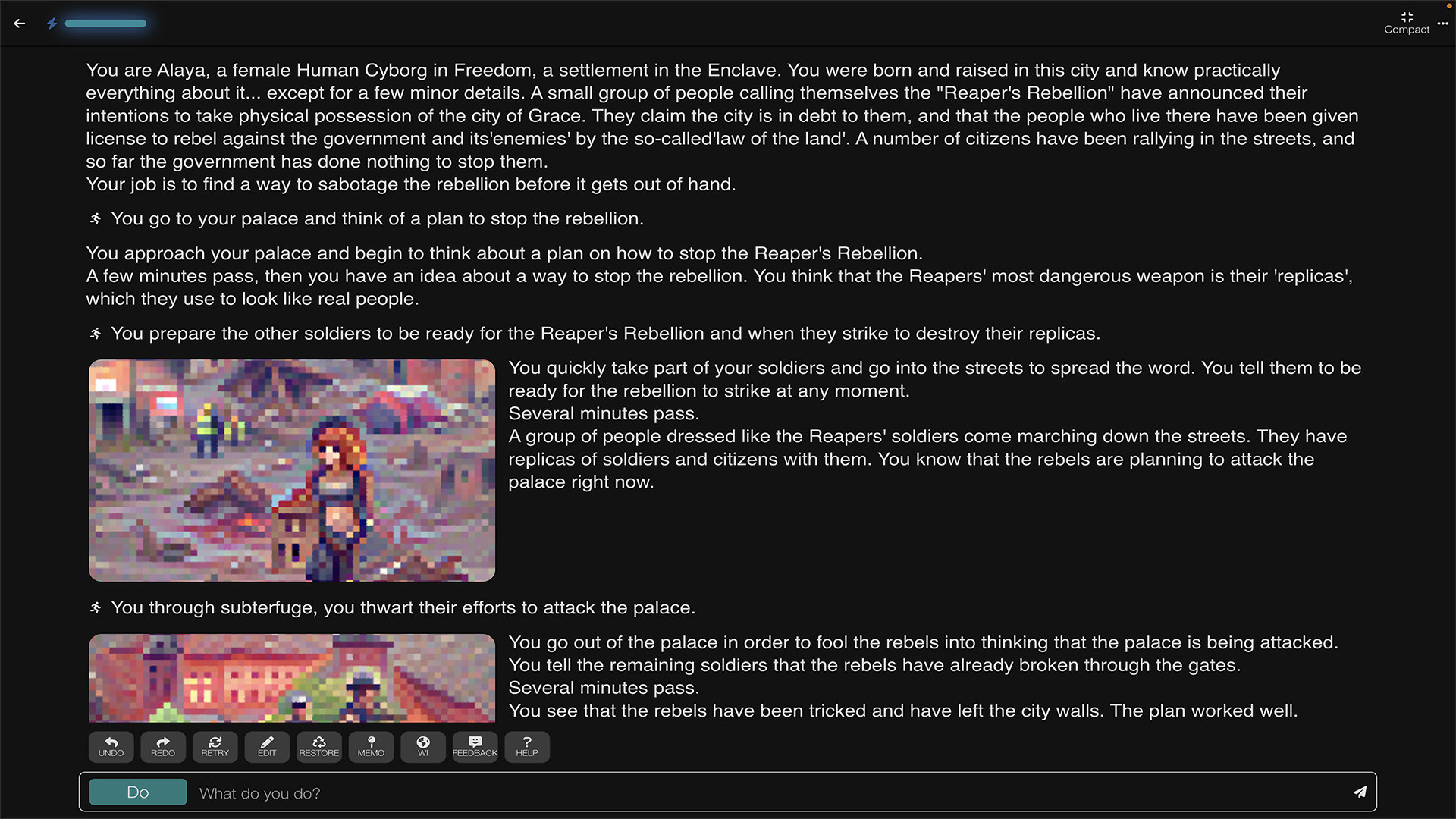
For those who love storytelling, AI Dungeon is a treat. It’s an interactive platform where users craft stories and the AI responds dynamically, adapting the narrative based on user inputs.
AI Dungeon showcases the potential of AI not just as a writing tool, but as a collaborative storytelling companion.
Pros of AI Dungeon
- Limitless Creativity. AI Dungeon offers an unparalleled canvas for creativity, allowing users to craft unique stories without the constraints of predefined plotlines. The AI responds dynamically, adapting the narrative based on user inputs, making every story a unique exploration.
- Adaptive Storytelling. AI Dungeon adapts to user choices and inputs, creating a personalized storytelling experience. This adaptability fosters a sense of ownership over the narrative, making users feel more connected to the story’s development.
Cons of AI Dungeon
- Inconsistent AI Responses. AI Dungeon’s AI might occasionally provide responses that lack coherence or relevance to the user’s inputs. This inconsistency can disrupt the flow of the narrative and result in unexpected plot developments.
- Lack of Narrative Control. While AI Dungeon offers creative freedom, it might struggle with maintaining a cohesive narrative structure. Users might find it challenging to steer the story in a specific direction or achieve a desired outcome.
8. ShortlyAI

Summoning writer’s block? ShortlyAI comes to the rescue with its AI-generated writing prompts. It’s a fantastic tool for writers looking to overcome the initial hurdle of getting started.
We’ve all been there – staring at a blank page. ShortlyAI is like a brainstorming buddy that kickstarts your creativity.
Pros of ShortlyAI
- Diverse Writing Styles. ShortlyAI can mimic various writing styles, catering to different needs and industries. Whether it’s blog posts, marketing copy, or technical content, the tool can adapt its output to match the desired tone and style.
- Language Enhancement. ShortlyAI can suggest improvements to sentence structure, grammar, and word choice. It acts as a real-time editor, helping writers refine their content and ensuring it meets high linguistic standards.
Cons of ShortlyAI
- Content Originality. While ShortlyAI aids in content generation, ensuring the originality of the output is a concern. Users must review and edit the content to prevent issues related to plagiarism or content similarity.
- Dependency on AI. Relying heavily on ShortlyAI for content creation might hinder writers from honing their natural writing skills. Over-reliance on the tool could compromise the authenticity and creativity of the content.
9. ScriptBook
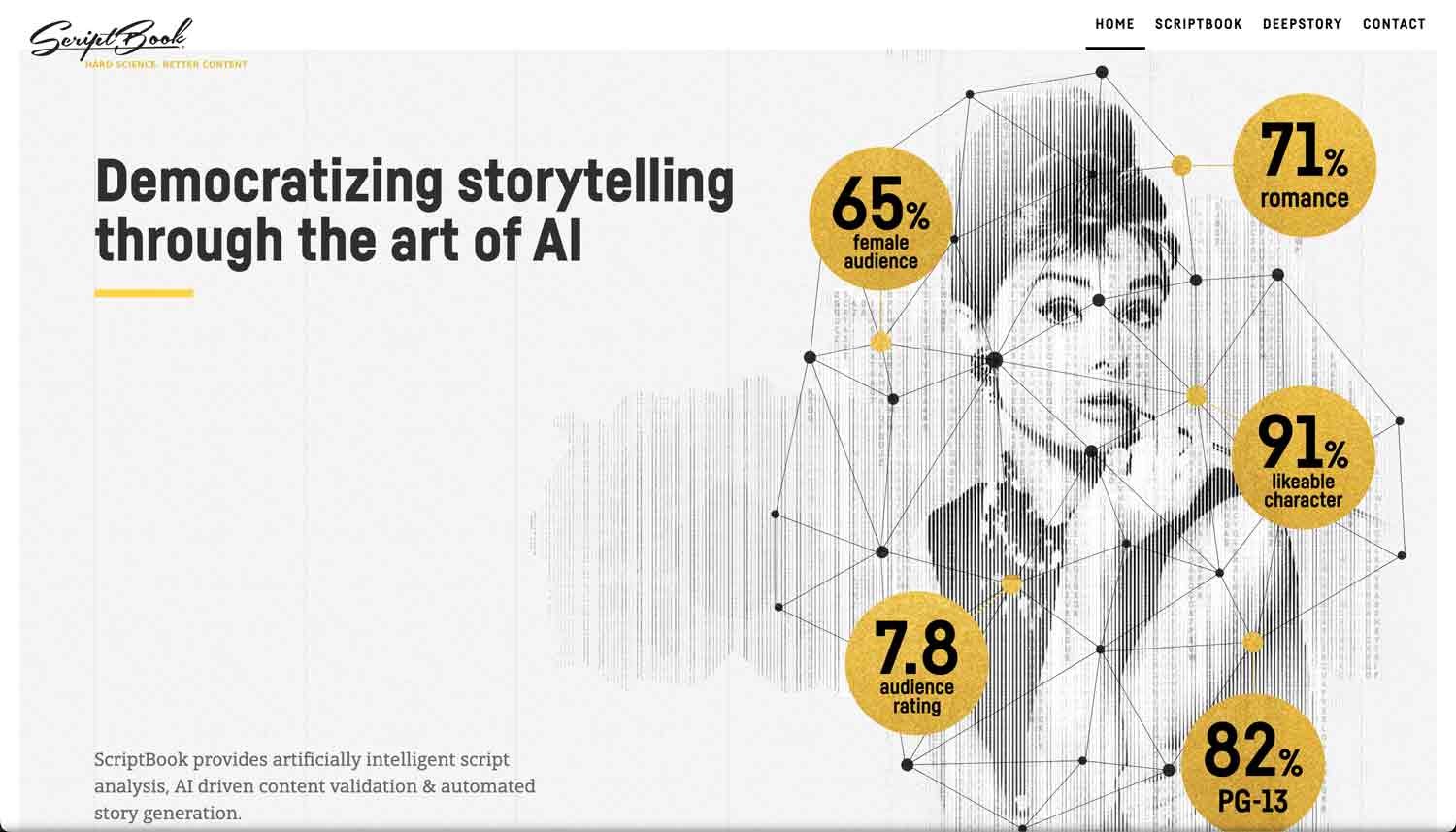
Scriptwriters, rejoice! ScriptBook analyzes screenplays and provides insights into their potential performance, making it an invaluable tool for filmmakers and scriptwriting enthusiasts.
ScriptBook’s AI predicted the box office success of the film Deadpool before it was released, showcasing the accuracy of its analysis.
Pros of ScriptBook
- Efficient Script Analysis. ScriptBook’s AI-driven analysis can quickly evaluate scripts and provide insights into various elements such as character dynamics, plot structure, and genre conventions. This efficiency can streamline the script assessment process.
- Data-Driven Predictions. By leveraging data and algorithms, ScriptBook aims to predict a screenplay’s potential success in terms of box office performance. This data-driven approach can provide valuable insights for filmmakers, producers, and investors.
Cons of ScriptBook
- Limited Contextual Understanding. While ScriptBook uses algorithms to analyze scripts, its ability to fully grasp the nuanced context, themes, and artistic intent of a screenplay might be limited. Writers should consider the AI’s analysis as one perspective among others.
- Inaccurate Predictions. AI-based predictions, while data-driven, can still be subject to inaccuracies. ScriptBook’s success predictions may not take into account unforeseen variables or the emotional impact of a film on audiences.
10. Kafkai
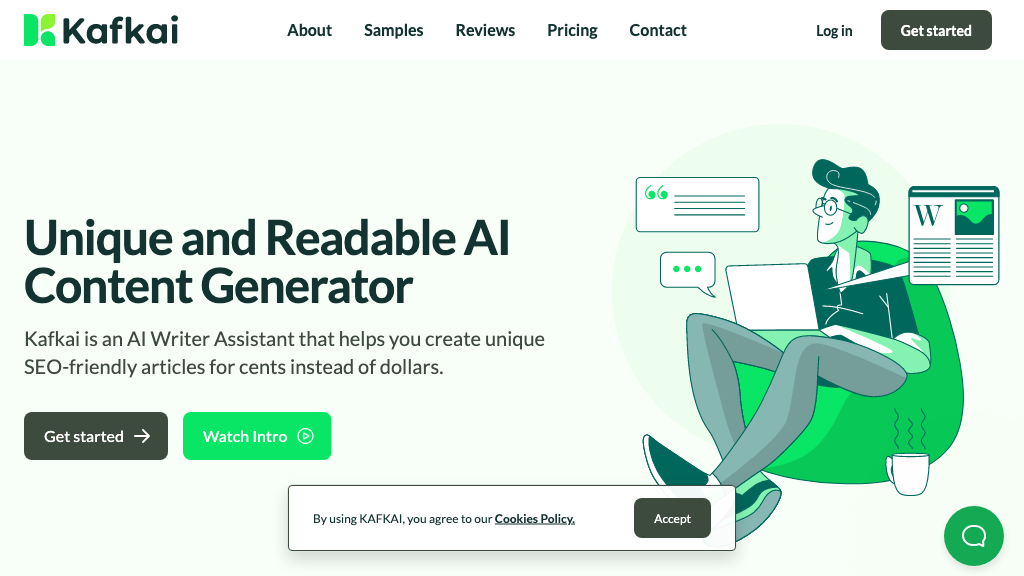
Creating long-form content can be a daunting task, but Kafkai simplifies it by generating entire articles from outlines. It’s a time-efficient solution for bloggers and content marketers.
Imagine having an AI-powered co-writer that helps you craft detailed articles without breaking a sweat.
Pros of Kafkai
- Efficient Content Generation. Kafkai excels in swiftly generating content across different genres and topics. Its efficiency can significantly expedite the content creation process, saving writers valuable time and effort.
- Diverse Writing Styles. Kafkai is capable of adapting its writing style to suit various tones and industries. Whether it’s technical content, marketing copy, or creative writing, the tool can produce content that aligns with different needs.
Cons of Kafkai
- Originality and Plagiarism. While Kafkai aids in content creation, ensuring the originality of the generated content is essential. Users must carefully review and edit the output to prevent issues related to plagiarism or content duplication.
- Contextual Accuracy. Kafkai’s AI might sometimes struggle with accurately grasping the context of specific topics or industries. Writers need to review and adjust the generated content to ensure it aligns with the intended subject matter.
11. Talk to Transformer

This tool allows users to input a prompt and receive AI-generated text that expands upon the provided input.
Pros of Talk to Transformer
- Creative Assistance. Talk to Transformer can provide creative assistance by generating text that expands on user prompts. This can be particularly helpful for writers seeking inspiration or looking to explore new ideas.
- Diverse Content Generation. The tool is capable of producing content on a wide range of topics and styles. This versatility allows users to generate text for various purposes, such as articles, stories, dialogues, and more.
Cons of Talk to Transformer
- Lack of Contextual Understanding. While Talk to Transformer can generate text based on user prompts, it might struggle to fully understand the context and nuances of certain inputs. This can lead to responses that are contextually inaccurate or irrelevant.
- Inconsistency in Quality. The quality of AI-generated text from Talk to Transformer can vary widely. Some responses might be coherent and relevant, while others might lack logical flow or accuracy.
12. ContentBot
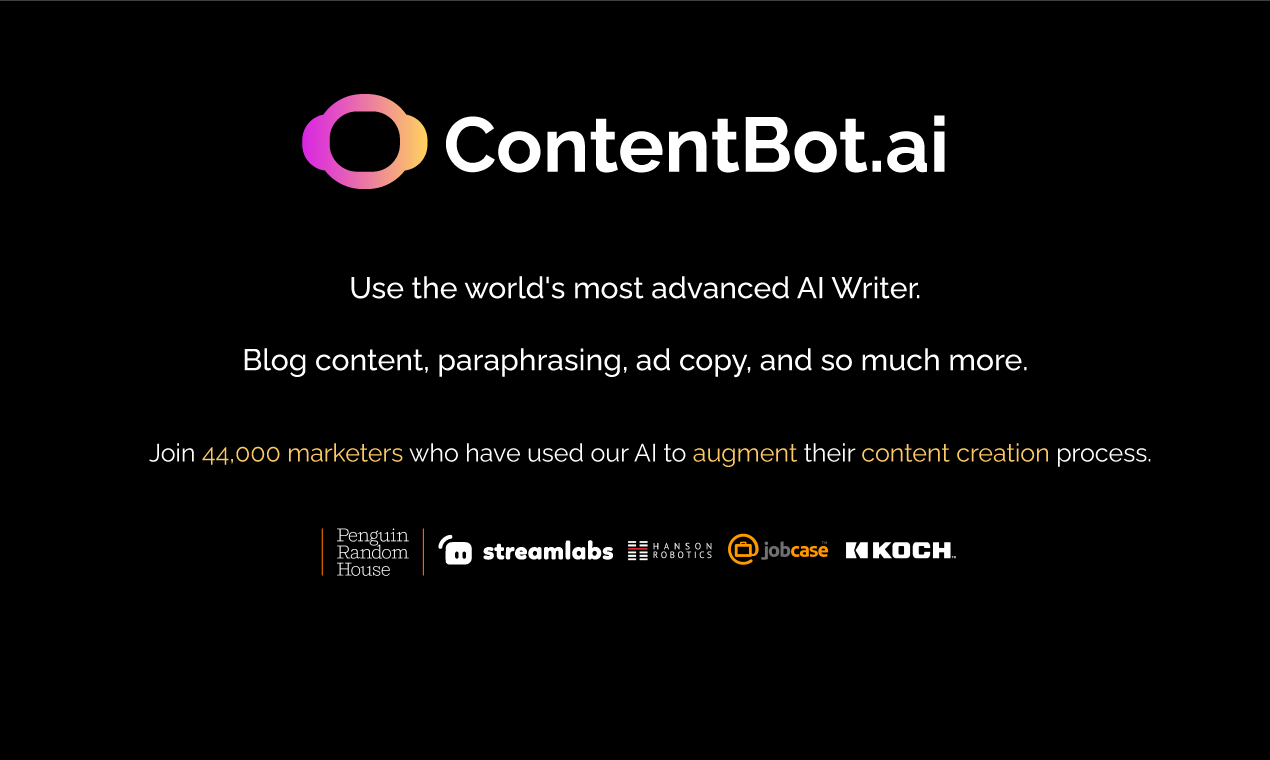
ContentBot helps users create articles, blog posts, and other written content by suggesting ideas and generating text.
Pros of ContentBot
- Idea Generation. ContentBot can help users generate ideas for articles, blog posts, and other written content. It offers prompts and suggestions that can spark creative thinking and inspire new topics.
- Efficient Content Creation. For writers facing tight deadlines, ContentBot’s quick content generation can be a valuable asset. It allows users to generate drafts swiftly, providing a foundation for more in-depth writing.
Cons of ContentBot
- Content Originality. While ContentBot aids in content creation, ensuring the originality of the generated content is essential. Users need to review and edit the output to prevent issues related to plagiarism or content similarity.
- Contextual Understanding. ContentBot’s AI might occasionally struggle with fully understanding the context and nuances of specific topics. Users should review the generated content to ensure it aligns with the intended subject matter.
13. Articoolo
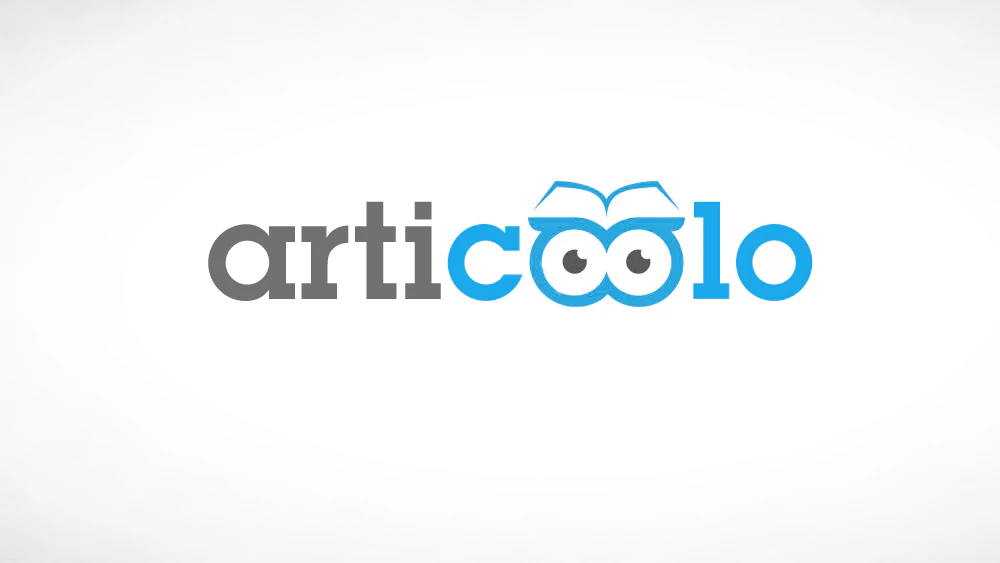
Articoolo uses AI to create short articles based on user-provided keywords, making it useful for generating content for websites and blogs.
Pros of Articoolo
- Quick Article Generation. Articoolo’s standout feature is its ability to rapidly generate short articles based on keywords. This can be a time-efficient solution for those looking to create content quickly.
- Idea Exploration. Articoolo can provide users with ideas and insights related to their chosen keywords. This can be particularly helpful for content creators seeking inspiration for their writing.
Cons of Articoolo
- Content Originality. Ensuring the originality of the generated content is essential. While Articoolo creates articles, users should review and edit the output to prevent issues related to plagiarism or content similarity.
- Contextual Understanding. Articoolo’s AI might struggle with fully grasping the context and nuances of specific topics. Users should review the generated content to ensure it aligns accurately with the intended subject matter.
14. Snazzy AI
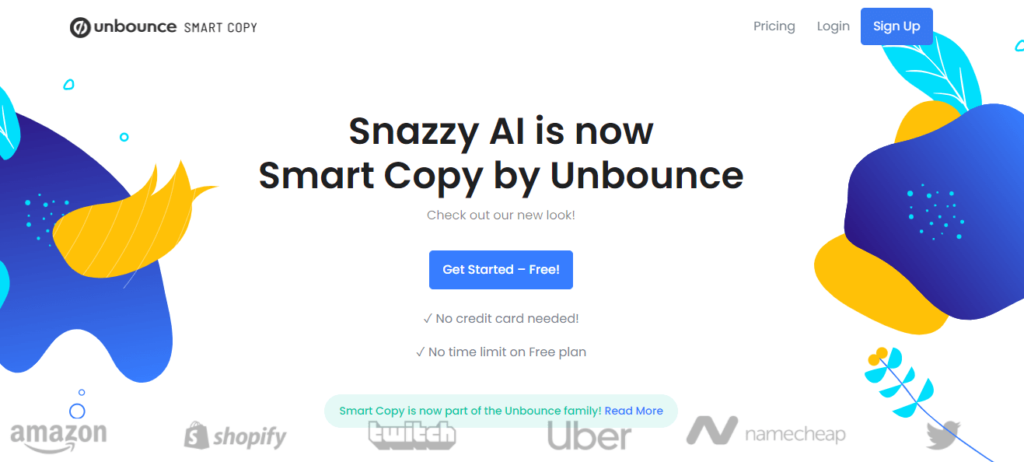
Snazzy AI focuses on generating creative and engaging content for social media posts, ad campaigns, and marketing materials.
Pros of Snazzy AI
- Engaging Copy Generation. Snazzy AI excels in generating catchy and persuasive marketing copy, making it a valuable asset for creating attention-grabbing advertisements and promotional content.
- Time Efficiency. For marketers facing tight deadlines, Snazzy AI’s rapid content generation can be a game-changer. It allows for quick creation of content that can be readily used in marketing campaigns.
Cons of Snazzy AI
- Originality and Authenticity. While Snazzy AI assists in content creation, ensuring the originality and authenticity of the generated marketing content is crucial. Users need to review and edit the output to prevent issues related to plagiarism or content similarity.
- Contextual Understanding. Snazzy AI’s AI might occasionally struggle with fully grasping the context of specific industries or products, resulting in content that lacks accuracy or resonance with the target audience.
15. SEO Content Machine

This tool assists in creating SEO-friendly content by generating keyword-rich articles and blog posts.
Pros of SEO Content Machine
- Keyword-Centric Content. SEO Content Machine excels in generating content that incorporates relevant keywords and phrases. This focus on SEO optimization can contribute to improved search engine rankings and visibility.
- Efficiency in Bulk Content. For those needing to produce a large volume of SEO-optimized content, SEO Content Machine’s ability to generate bulk content can save time and effort in the content creation process.
Cons of SEO Content Machine
- Content Originality. While SEO Content Machine assists in generating content, ensuring the originality of the output is crucial. Users should review and edit the content to prevent issues related to plagiarism or content similarity.
- Contextual Understanding. The tool’s AI might struggle to fully understand the context and nuances of specific industries or topics. Users should review the generated content to ensure it aligns accurately with the intended subject matter.
The Ethical Landscape of AI Writing
While AI writing programs offer remarkable convenience and efficiency, they also raise ethical considerations. The content produced by AI tools often blurs the line between human-generated and machine-generated text. This has prompted discussions about transparency, authenticity, and the potential for misuse.
The Future of Writing: A Human-AI Collaboration
In conclusion, AI writing programs have ushered in a new era of content creation, offering writers a toolkit of versatile solutions to enhance their productivity and elevate the quality of their work. From basic grammar checks to generating entire articles, these tools showcase the immense potential of AI in the realm of writing. As we navigate this evolving landscape, it’s essential to embrace AI as a powerful ally while also upholding the authenticity and creativity that define human expression. The future beckons – a future where humans and AI work hand in hand to create content that resonates and inspires.

David’s journey in the tech world began as a system administrator and he has since transitioned to a new IT role in a different company. Over the years, his extensive knowledge and practical experience have made him a trusted go-to resource for friends and acquaintances seeking help with computer-related issues. Recognizing the value of his accumulated knowledge, David transformed his initial idea of a personal blog into a platform aimed at helping others.
He takes pride in crafting detailed and user-friendly articles and guides, ensuring that even novice computer users can benefit from his insights.
Send your message for David here and learn more about him.
